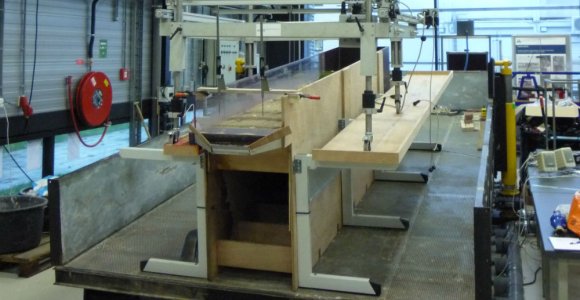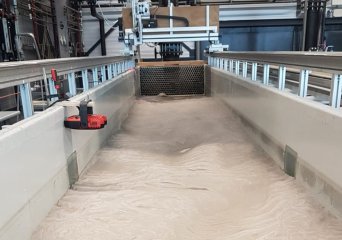
Facility
Kraijenhoff van de Leur Laboratory for Water and Sediment Dynamics
The experimental research of the Laboratory for Water and Sediment Dynamics mainly focuses on morphological responses to channel flow and overland flow. Current research topics are in the fields of stream restoration, gully erosion, side channels created by longitudinal dams and bedform dynamics.
Facilities

Straight Flume
The straight flume has an effective length of 13.6 m and an internal width of 2.6 m and features a sediment catch, which can be connected to the sediment pump for recirculation of sediment.
| Total lenght | 18.0 m |
| Test reach length | 12.8 m |
| Width | 2.6 m |
| Depth | 0.7 m |
| Inclination | 0 |
| Maximum discharge | 190 l/s |
| Discharge sediment pump | 4 l/s |
| Resolution bed scanner | 1 mm2 |

Tilting flume
The tilting flume is a 1.2 m wide tilting flume, with an effective length of 14.4 m. The flume has sediment catch at the downstream end, and a sediment pump for recirculation of bed material.
| Total length | 17.1 m |
| Test reach length | 14.4 m |
| Width | 1.2 m |
| Depth | 0.5 m |
| Maximum inclination | 4% |
| Maximum discharde | 190 l/s |
| Discharge sediment pump | 4 l/s |

Rainfall simulator
To test the impact of a raindrop on a soil surface and test the vulnerability of a soil type to overland flow and erosion, a rainfall simulator has been installed with different rainfall intensities.
| Test reach length | 6.0 m |
| Width | 2.5 m |
| Depth | 0.6 m |
| Maximum inclination | 15 degrees |
| Height nozzles | 3.0 m |
Teaching facilities
Closed conduits model
Two types of energy losses in closed conduits can be studied in this model:
- friction losses (caused by friction at the inner wall of the conduit) and;
- local losses (caused by sudden changes in the conduit).
Small demonstration flume
This 2.5 m long and 0.08 m wide flume provides students with the ability to study fluid flow phenomenon associated with weirs and sluice gates. Sediment can also be applied to the bed to demonstrate bedform dynamics and sediment transport. The flow system is entirely self-contained and the flume is portable meaning it can be move into any suitable laboratory or class environment for use.
Large demonstration flume
This 5 m long and 0.3 m wide flume allows students to study a wide range of topics including the hydraulics associated with different types of weir and sluice gate. Bed roughness and channel slope can also be adjusted and the apparatus includes a closed sediment circuit which allows a sand sediment load to be fed into the flow enabling bedload transport rates and phenomenon such as local scour around bridge piers to be investigated.
Venturi meter and orifice
Measuring discharges in closed conduits is possible with an orifice or Venturi meter. Students learn how these widely used systems are working by applying the energy conservation law and the equation for continuity of mass.
Research

Publications
Physical scale model of a training dam
Physical scale model with a mobile bed composed of lightweight sediment to establish morphodynamic behaviour around a training dam (River Rhine - The Netherlands)

Overland flow experiments
Poster presentations for opening of Kraijenhoff van de Leur Laboratory.

Impact of silt on bedforms and sediment transport
A flume model to test the influence had by silt concentration in sand-silt mixtures upon channel bedform geometry and sediment transport rates.
Education
Several courses, given by the chairgroups HWM and SLM from Wageningen University offers make use of the facilities from WSL. The lab also provides a practical space for both BSc and MSc students, to carry out experiments for their thesis.
Read more
Wageningen University offers, spread over multiple chair groups, a number of courses that use the facilities of the Kraijenhoff van de Leur Laboratory for Water and Sediment Dynamics.
Introduction to Hydraulics
This course is designed for students who need a basic knowledge about hydraulics as an introduction to application oriented courses such as the design of irrigation systems and hydraulic structures. By concentrating on a detailed explanation of the laws of conservation of mass, momentum and energy, the course aims at providing the student a clear understanding of steady water flow through conduits, rivers, canals and soils. The course uses a reader which is compatible with this set-up. In this text book, proofs, derivations, theory and worked examples are given in full, but using simple mathematical notation and an ample amount of clarifying text. The following topics are covered: hydrostatics, measurement of pressure, flow and discharge, flow through pipelines, uniform and non-uniform open channel flow and steady flow around hydraulic structures. The course provides basic knowledge of hydraulics and hydrometry for application in the fields of irrigation, river design, drainage, erosion, water conservation and flood protection.
Fluid Mechanics
The course focuses on the processes governing fluid flow of water as well as air and the associated dynamical forces and energy. The three most important conservation laws will be discussed: conservation of mass, conservation of momentum and conservation of energy. The subjects of vorticity and system rotation will be discussed in detail. The basic differences between water (incompressible) and air (semi-incompressible) and their consequences on the fluid flow characteristics will be discussed. The course will provide an elaborate introduction to kinematics, dimensional analysis, laminar flow, boundary layer theory and turbulence. By the end of the course, an overview of modelling approaches is offered.
River flow and morphology
The course deals with advanced topics of river flow and morphology, emphasizing hydrodynamics, sediment transport and morphodynamics in rivers and streams. It first covers the basics of one-dimensional channel flow by deriving the St. Venant equations, and presents solution methods. Simplifications to the St. Venant equations are introduced that lead to kinematic and diffusion wave approximations, being the bases for flood routing methods. Next, flow curvature and the associated secondary circulation in river bends are discussed, including the derivation of a set of governing equations. The course proceeds with bulk properties of sediment, further focusing on the foundations of bedload and suspended load sediment transport. Bedform dynamics in rivers are subsequently analysed with the main focus on alternative types of bedforms and the associated resistance to the flow. The final lectures address river morphological concepts and introduce one-dimensional analytical models simulating riverbed evolution, both theoretically and in computer exercises. A significant portion of time is dedicated to the analysis of flow, sediment transport and bedform dynamics in the Kraijenhoff van de Leur Laboratory for Water and Sediment Dynamics.
Environmental Hydraulics
The course provides basic knowledge of hydraulics for application in quantitative water management (e.g. design of rivers, flood protection measures and hydraulic structures). By concentrating on a detailed explanation of the laws of conservation of mass, momentum and energy, the course aims at providing the student a clear understanding of steady water flow through conduits, rivers and canals.
Land and Water Engineering
Land Degradation & Remediation
Land Degradation and Remediation (SLM-10306) is an introductory BSc course which provides a general overview on the topics of land degradation processes, their measurement, conservation strategies and sustainable intervention options. The course contains three parts: A) Recognizing and understanding land degradation B) Conservation and remediation options C) How approaches to solving land degradation issues works in reality?
Contact
Lab managers
Hydrology and Quantitative Water Measurement Group
Soil Physics and Land Management Group
Location
Google Maps
Click here for a link to the exact location of the WSL Lab on Google Maps.


